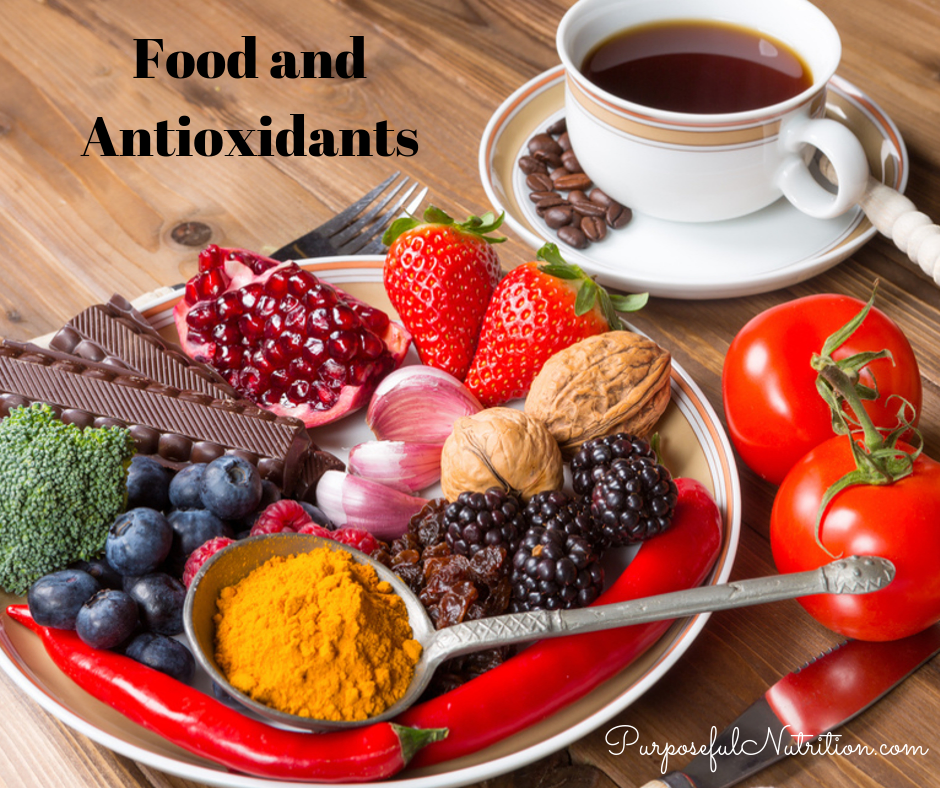This post may contain affiliate links which won’t change your price but will share some commission.
You’ve probably heard the term, “antioxidants.” And you may know that they’re good for you and that you can find them in food. You can also find them in beauty products, vitamins, and nutritional products. What you may not know is exactly what they are, and what they do for you and your body.
What Are Antioxidants?
In technical terms, an antioxidant is a substance that inhibits or stops the oxidation of other molecules. Okay, great – right? What’s oxidation and why does that matter? Well, when something is oxidized it loses electrons. It’s now called a free radical which means that it can, and wants to, bind with something. There’s room. And it can wreak havoc and cause damage to your tissues.
These radicals can start chain reactions. These oxidized elements actually steal electrons from other molecules, which damages them.
Now your body can handle some free radicals. It’s used to it and it’s generally prepared to deal with it. However, our lifestyle has changed enough that we now tend to have many more of these little buggers running around in our bodies. They’re caused by environmental problems like pollution, pesticides, and even exposure to cigarette smoke.
Antioxidants Neutralize Free Radicals
Antioxidants, as mentioned, negate the damage of free radicals. They protect your cells and help ensure you don’t suffer the damage from free radicals. So what damage can free radicals cause?
Some of the problems include (but aren’t limited to)
• Arthritis
• Neural degeneration, which can lead to Alzheimer’s
• Premature aging
• Coronary heart disease
• Some cancers
Antioxidants are found in some specific foods. There are three major antioxidants that you want to include in your diet every day. They are beta-carotene, vitamin C, and vitamin E. You can find antioxidants in abundance in colorful veggies and fruits. Look for purple, red, blue, and orange produce.
You can also find them in interesting sources like coffee and tea, chocolate, and onions and garlic. The good news is that essentially if you eat a diet that is generally prepared from whole foods rather than processed foods, you’re probably getting an abundance of antioxidants with every meal.
Focus on making sure that you’re getting enough fruits and vegetables and you’ll be well on your way to preventing excess damage caused by free radicals.
We’ve talked a lot about the nutrients that people generally consider to be healthy – vitamins and minerals. However, your body cannot even metabolize many vitamins and minerals without two other important nutrient categories. We’re talking about protein and fat.
Protein
Your body is protein. It’s in every cell and tissue. Enzymes are made from protein, as are your hormones and components of your blood. Your hair, nails and of course your muscles all are made from protein.
Protein isn’t stored in your body. You have to consume it and this is where many people get into trouble. Vegetarians often don’t get enough protein, though many other people don’t either. There’s a misperception that Americans often get too much protein. The IOS has the following recommendation:
Adults need to get a minimum of 8 grams of protein for every 20 pounds of body weight. So if you weigh 150 pounds, you’d want to get at least 60 grams each day. Athletes and active individuals may need more protein.
The challenge when you’re talking about complete health is to find sources of protein that come from foods that also provide other nutrients. For example, salmon is a protein that comes with omega-3 fatty acids, lentils are packed with protein and an abundance of vitamins and minerals, and eggs come with minerals too. Grass fed and pastured meats have many important nutrients along side protein and fats. This is why the quality of your meat really matters. Grass fed beef is a good source of CLA, confugated linoleic acid, A hamburger from a grass–fed cattle has two and a half times more conjugated linoleic acid (CLA) than an equally lean hamburger from cattle raised in a feedlot. CLA is a healthy fat that has been shown to fight obesity, cancer, and diabetes in lab animals. 1
Fat
When it comes to fat, it is true that your body needs fat. What it needs are fats from plants and from pastured and grass fed meats. Again, as mentioned above animals and meats which are raised in a healthy environment and on the foods they were designed to eat, are the way to go. That means cows should be eating grass and chicken should be free ranging, to eat bugs and seeds and such. When chickens are fed, they need non-gmo and non soy food. And all animals should not be getting routine antibiotics to protect against infections and diseases that come from unhealthy living conditions. Sometimes it means finding a local farmer to work with to find affordable meats for you and your family.
Plants that contain fats include avocados, nuts and seeds, and it’s fat that is good for you. When you’re looking at your plate of food,there should be plenty of organic vegetables and plants. However, you do want to have some room devoted to both fats and protein. A balanced diet is the best way to get complete nutrition.


Leave a Reply